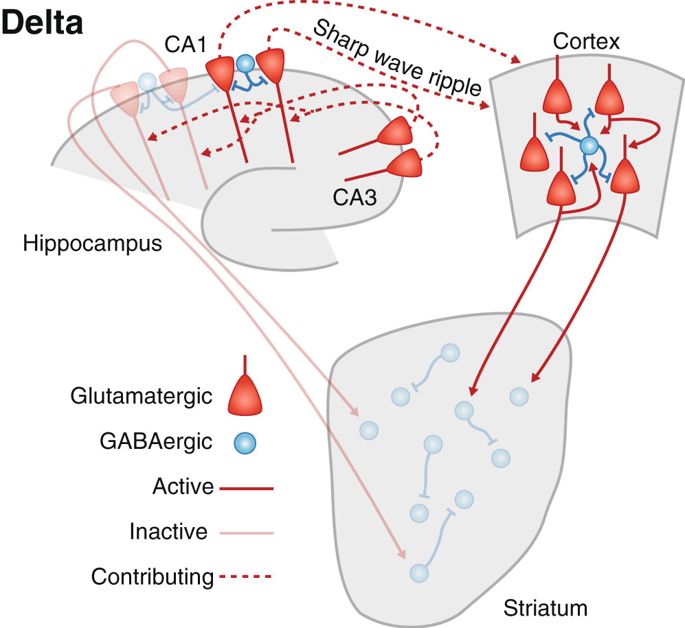npj Science of Learning ( IF 4.2 ) Pub Date : 2017-01-05 , DOI: 10.1038/s41539-016-0001-2 Drew B Headley 1 , Denis Paré 1

|
The cortex, hippocampus, and striatum support dissociable forms of memory. While each of these regions contains specialized circuitry supporting their respective functions, all structure their activities across time with delta, theta, and gamma rhythms. We review how these oscillations are generated and how they coordinate distinct memory systems during encoding, consolidation, and retrieval. First, gamma oscillations occur in all regions and coordinate local spiking, compressing it into short population bursts. Second, gamma oscillations are modulated by delta and theta oscillations. Third, oscillatory dynamics in these memory systems can operate in either a “slow” or “fast” mode. The slow mode happens during slow-wave sleep and is characterized by large irregular activity in the hippocampus and delta oscillations in cortical and striatal circuits. The fast mode occurs during active waking and rapid eye movement (REM) sleep and is characterized by theta oscillations in the hippocampus and its targets, along with gamma oscillations in the rest of cortex. In waking, the fast mode is associated with the efficacious encoding and retrieval of declarative and procedural memories. Theta and gamma oscillations have similar relationships with encoding and retrieval across multiple forms of memory and brain regions, despite regional differences in microcircuitry and information content. Differences in the oscillatory coordination of memory systems during sleep might explain why the consolidation of some forms of memory is sensitive to slow-wave sleep, while others depend on REM. In particular, theta oscillations appear to support the consolidation of certain types of procedural memories during REM, while delta oscillations during slow-wave sleep seem to promote declarative and procedural memories.
中文翻译:

跨多个存储系统的常见振荡机制
皮层、海马体和纹状体支持可分离形式的记忆。虽然这些区域中的每一个都包含支持各自功能的专门电路,但所有区域都以 delta、theta 和 gamma 节律来构建其跨时间的活动。我们回顾了这些振荡是如何产生的,以及它们在编码、巩固和检索过程中如何协调不同的记忆系统。首先,伽马振荡发生在所有区域并协调局部尖峰,将其压缩为短暂的群体爆发。其次,伽马振荡由德尔塔和西塔振荡调制。第三,这些记忆系统中的振荡动力学可以以“慢”或“快”模式运行。慢模式发生在慢波睡眠期间,其特征是海马体中的大量不规则活动以及皮质和纹状体回路中的δ振荡。快速模式发生在主动清醒和快速眼动 (REM) 睡眠期间,其特征是海马体及其目标区域中的 θ 振荡,以及其余皮层中的 γ 振荡。清醒时,快速模式与陈述性记忆和程序性记忆的有效编码和检索相关。尽管微电路和信息内容存在区域差异,但 Theta 和 gamma 振荡与多种形式的记忆和大脑区域的编码和检索具有相似的关系。睡眠期间记忆系统振荡协调的差异可能解释了为什么某些形式的记忆巩固对慢波睡眠敏感,而另一些则依赖于快速眼动睡眠。特别是,θ 振荡似乎支持快速眼动睡眠期间某些类型的程序性记忆的巩固,而慢波睡眠期间的 delta 振荡似乎促进陈述性和程序性记忆。



























 京公网安备 11010802027423号
京公网安备 11010802027423号